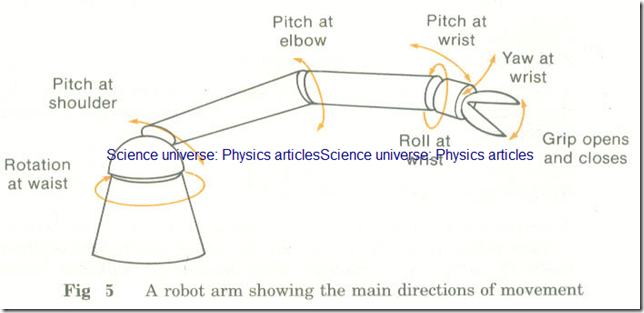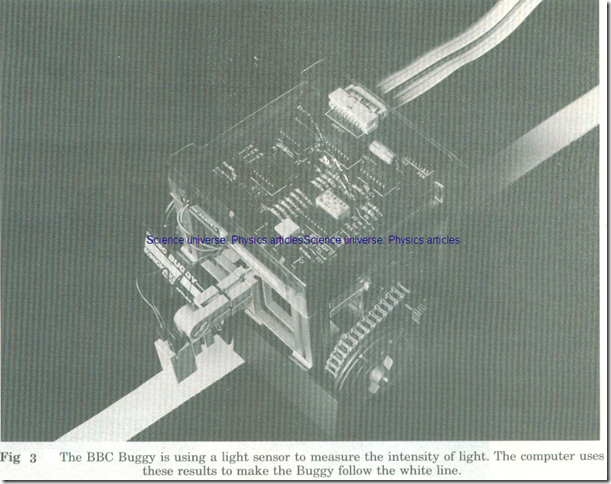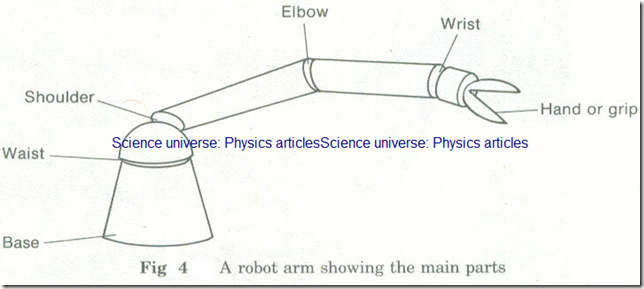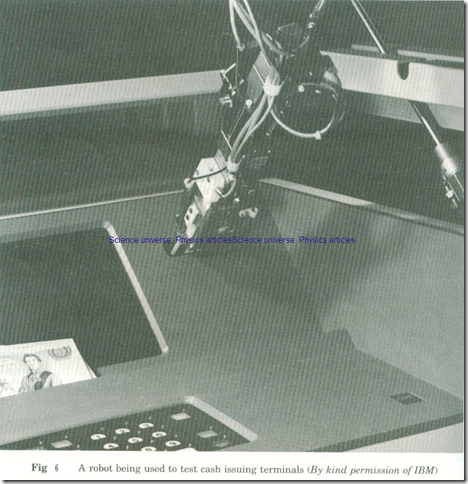Robots
A robot is a device which can be programmed to do work which otherwise has to be done by people. (Robotnik is Czech for a workman.)
An android is a robot which looks like a human being. These tend to be the type of robots featured in science fiction films. However most modern robots are not androids, although many have parts and movements which copy those of humans, particularly the human arm.
MOTION
Many robots cannot move bodily from place to place.
Those which can have various means for moving:
Wheels
Small wheels are suitable for fast movement on flat surfaces. Large wheels can be used for slow movement on rough surfaces. A large number of wheels makes a robot stable.
A small number of wheels gives better control of movement.
Examples of robots with wheels
1 PENMAN – a device which is connected to a computer by a cable and used to draw graphics on paper. It only has two wheels so that it is very manoeuvrable.
2 A robot for moving parts around a factory.
Caterpillar tracks
This is a continuous belt, as on a tank.
Fitted to robots which have to move slowly, possibly over difficult terrain. Movements can be controlled accurately.
Examples of robots with caterpillar tracks
1 The BBC Buggy-this is an educational robot which can be controlled by a BBC computer (see Fig 3).
2 The robot used by the British Army in Northern Ireland to detonate bombs.
Legs
It is relatively difficult to make a robot walk on two legs because every time it raises one leg it has to balance on the other one. Robots with several legs are used for slow movement over very rough ground.
Gantry
In some factories and warehouses a robot which has to move within a small area can be suspended on a framework moved by cables.
STATIONARY ROBOTS
Many industrial robots are fixed in position.
Usually the parts and movements are similar to those of a human arm (see Fig 4)-they have a waist, a shoulder, an elbow, a wrist and a hand. The ability of a robot to move is measured by its degrees of freedom.
A degree of freedom is the ability to swing or to rotate in a particular direction at a particular joint.
Each main joint of a robot may allow any of the following three movements (see Fig 5):
1 Pitch-movement vertically up and down,
2 Yaw -movement left or right across the joint,
3 Roll – rotation clockwise or anticlockwise.
Examples of degrees of freedom
1 A wrist normally has three degrees of freedom. The hand can pitch and yaw and roll.
2 A simple industria1 robot usually has seven degrees of freedom. It has one at the waist (rotation), one at the shoulder (pitch), one at the elbow (pitch), three at the wrist and one at the hand (opening and closing) (see Fig. 5).
Fig 3 The BBC Buggy is using a light sensor to measure the intensity of light. The computer uses these results to make the Buggy follow the white line.
Fig 4 A robot arm showing the main parts
 Fig 5 A robot arm showing the main directions of movement
Fig 5 A robot arm showing the main directions of movement
Examples of stationary robots
1 A robot to test cash issuing terminals before they are installed at banks Each terminal has to be tested for several hours before being installed in a bank. The robot inserts cards and presses the appropriate buttons on the terminal, taking the money and stacking it (see Fig 6). It selects a card from 10 different cards and carries out different types of transactions so that the test simulates real use by customers.
The terminal does not have to be positioned very carefully as the robot can find the terminal and memorize where it is.
This robot will only work when no one is near it. To avoid hurting anyone the robot moves to a safe point and stops when anyone approaches.
Fig 6 A robot being used to test cash issuing terminals (By kind permission of IBM)
2 A robot used in car manufacture
A car factory may contain a number of robots. Often many of them are of the same type, but they may have different hands and each one is separately programmed for its own task (such as welding).
SENSORS AND FEEDBACK
A simple robot will carry out a set sequence of operations whatever happens.
More complex robots use sensors to record the results of their actions. They then use the feedback principle to change their actions to suit the situation (for feedback see the introduction to this topic).
Examples of the use of sensors and feedback
1 (a) A simple robot designed to paint metal panels will only paint the shape it is programmed to paint and if the conveyor supplying it with panels is stopped it may paint thin air.
(b) A more complex robot also paints metal panels. This one is fitted with a video camera to record the shape of a panel. It can paint panels of different shapes and its sprayer is automatically switched off if no panel is present.
2 A mobile robot carrying parts in a car factory has a light sensor and uses it to follow a white line on the factory floor. If the sensor shows a low light reading the robot is not properly following the line. The processor adjusts the direction until the light level rises again, showing that the line is being followed.
PROGRAMMING
The computer processor controlling a robot may be contained in the robot or it may be separate. If separate it may be connected by a cable or it may send signals to the robot, for instance by radio waves or microwaves.
The computer is programmed to control the robot. Even lithe program does not include any feedback the program will contain a large number of instructions.
Methods of entering a program include:
1 Writing a program of movements and typing them at a keyboard.
2 Switching the robot into ‘learn’ mode. Its arm can then be moved through the necessary sequence of movements and the computer memorizes them. The ann can be moved by hand or remotely using a joystick.
Advantages of robots
1 They can carry out a task repeatedly for hours without stopping.
2 They can operate in situations where humans cannot easily go (e.g. on other planets, deep in the ocean, probing explosives).
3 They do not make errors due to tiredness or lack of concentration.
Disadvantages of robots
1 They are expensive initially.
2 They can only cope with the particular situations they are built and programmed for.



